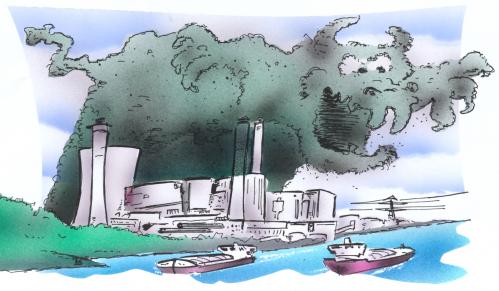 Cartoon courtesy of toonpool.com
Cartoon courtesy of toonpool.com
There is always a lot of controversy anytime longstanding federal regulations are changed. This time, the uproar came because the U.S. Environmental Protection Agency announced plans to increase the stringency of national air quality standards regarding nitrogen dioxide (NO2) emissions.
NO2 forms quickly from the emissions of cars, trucks, buses, power plants, and off-road equipment. In addition, the compound also contributes to the formation of ground-level ozone (also known as smog), and fine particle pollution, which is linked with a number of adverse effects on the human respiratory system.
There is a clear benefit to taking action to reduce NO2, but there is also concern among some in the scientific community about potential side effects to taking this action.
 Graphic courtesy of Hong Kong’s Environmental Protection Department.
Graphic courtesy of Hong Kong’s Environmental Protection Department.
“When you reduce NOx (the family of nitrogen oxides), you don’t just reduce ozone, you change the chemistry of the atmosphere in such a way that you end up increasing the amount of methane in the air, which is a potent gas when it comes to global warming,” said Jason West, assistant professor in the department of environmental sciences and engineering at the University of North Carolina to National Public Radio.
“I think we need to have policies which try to take into account both air quality and climate change. Traditionally, these have been entirely separate,” said Dr. Drew Shindell, specializing in stratospheric ozone depletion and global warming at NASA’s Goddard Institute for Space Studies.
Shindell is also the lead author of a 2006 study, finding that smog is a contributing factor to Arctic warming. That study found that “in the high-altitude region of the stratosphere, ozone acts to shield the planet from harmful ultraviolet radiation. In the lower portions of the atmosphere (the troposphere), the ozone can damage human health, crops, and ecosystems. Ozone is also a greenhouse gas and contributes to global warming.”
 Graphic courtesy of Environment Canada.
Graphic courtesy of Environment Canada.
Charles D. Connor, president and chief executive officer of the American Lung Association, is also among those in support of the EPA’s announcement. In an formal statement, he said, “We urge the agency to adopt the strongest, most protective standards when they make their final decision in August.
“Nearly two years ago, the EPA selected a standard for ozone that was too weak, allowing for more pollution than compelling research said was safe. In the coming months, the EPA will conduct public hearings on the issue. The American Lung Association will be there to urge the adoption of an ozone standard that follows the science and the law. The final smog standard is too critical to the health of millions to do otherwise.”
Some in the commercial sector are in stark opposition to the EPA’s plans. The American Petroleum Institute, a national trade association, released a statement saying, the “EPA rushed to a decision without completing a thorough review of the science in a manner that allowed proper public participation. EPA is over-regulating this air quality standard for political, not health reasons.
“National ambient NO2 concentrations are well below the current annual standard, and will continue to be reduced with new industrial and motor vehicle requirements irrespective of the new standard.”
The EPA has set the new one-hour standard for NO2 at a level of 100 parts per billion (ppb). The EPA is also retaining existing annual average standards of 53 ppb.
The EPA plans to establish new monitoring requirements in urban areas that will measure NO2 levels around major roads and across the communities. There are plans for monitors to be located near roadways in cities with at least 500,000 residents. Also, there are plans for larger cities and areas with major roadways to have additional monitors.
The EPA plans to designate which areas don’t meet the new standard by January 2012 based on the existing monitoring systems. New monitors have to begin operating no later than Jan. 1, 2013.
Supplemental Reading
Reader comments and input are always welcomed!